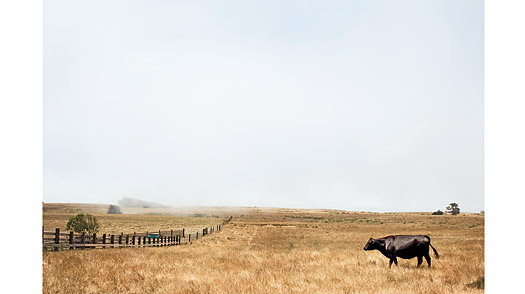
One of more than 100 cattle on Bill Niman's California property, home of an ongoing experiment in sustainable ranching.
(3 of 8)
But cheap food is not free food, and corn comes with hidden costs. The crop is heavily fertilized--both with chemicals like nitrogen and with subsidies from Washington. Over the past decade, the Federal Government has poured more than $50 billion into the corn industry, keeping prices for the crop--at least until corn ethanol skewed the market--artificially low. That's why McDonald's can sell you a Big Mac, fries and a Coke for around $5--a bargain, given that the meal contains nearly 1,200 calories, more than half the daily recommended requirement for adults. "Taxpayer subsidies basically underwrite cheap grain, and that's what the factory-farming system for meat is entirely dependent on," says Gurian-Sherman.
So what's wrong with cheap food and cheap meat--especially in a world in which more than 1 billion people go hungry? A lot. For one thing, not all food is equally inexpensive; fruits and vegetables don't receive the same price supports as grains. A study in the American Journal of Clinical Nutrition found that a dollar could buy 1,200 calories of potato chips or 875 calories of soda but just 250 calories of vegetables or 170 calories of fresh fruit. With the backing of the government, farmers are producing more calories--some 500 more per person per day since the 1970s--but too many are unhealthy calories. Given that, it's no surprise we're so fat; it simply costs too much to be thin.
Our expanding girth is just one consequence of mainstream farming. Another is chemicals. No one doubts the power of chemical fertilizer to pull more crop from a field. American farmers now produce an astounding 153 bu. of corn per acre, up from 118 as recently as 1990. But the quantity of that fertilizer is flat-out scary: more than 10 million tons for corn alone--and nearly 23 million for all crops. When runoff from the fields of the Midwest reaches the Gulf of Mexico, it contributes to what's known as a dead zone, a seasonal, approximately 6,000-sq.-mi. area that has almost no oxygen and therefore almost no sea life. Because of the dead zone, the $2.8 billion Gulf of Mexico fishing industry loses 212,000 metric tons of seafood a year, and around the world, there are nearly 400 similar dead zones. Even as we produce more high-fat, high-calorie foods, we destroy one of our leanest and healthiest sources of protein.
The food industry's degradation of animal life, of course, isn't limited to fish. Though we might still like to imagine our food being raised by Old MacDonald, chances are your burger or your sausage came from what are called concentrated-animal feeding operations (CAFOs), which are every bit as industrial as they sound. In CAFOs, large numbers of animals--1,000 or more in the case of cattle and tens of thousands for chicken and pigs--are kept in close, concentrated conditions and fattened up for slaughter as fast as possible, contributing to efficiencies of scale and thus lower prices. But animals aren't widgets with legs. They're living creatures, and there are consequences to packing them in prison-like conditions. For instance: Where does all that manure go?
